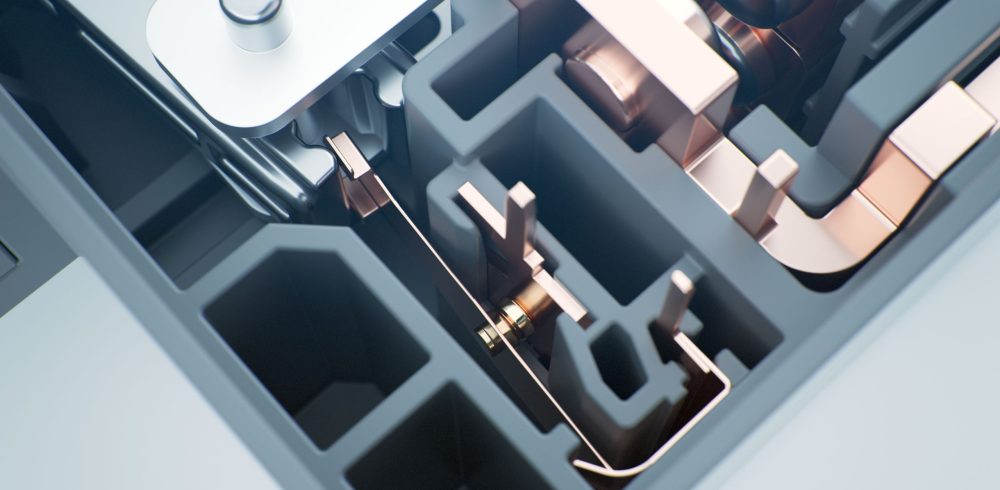Gruner AG is presenting a new generation of its 48 V relay at this year’s Battery Show Europe, which now interrupts short-circuit currents of up to 5 kA, withstands currents of up to 8 kA, and has a significantly increased shock resistance of 150 G. In addition, the relay has been equipped with an NTC as a temperature monitoring module, which can be used to check the functional status in the battery management system (BMS). B-samples of a smaller relay size will also be presented for the first time at the fair.
“The biggest challenge with an on-board power supply of 48 V battery is to safely separate the potential in the event of a malfunction or crash,” explains Robert Frank, Key Account Manager at Gruner AG. “Galvanic isolation in the load circuit is absolutely necessary, because as in the 400 V range, switching arcs also pose a problem in the 48 V on-board network.”
Due to the high electrical potential, an arc fault can be maintained here – in contrast to the 12 V range – and lead to damage in the vehicle. For this reason, Gruner had already developed a mechanical relay in 2015 that guarantees galvanic isolation and reliably extinguishes switching arcs of up to 3 kA. In the meantime, the requirements for the current load have increased significantly.
“More and more 48 V applications and consumers have been added to vehicles – including, for example, energy-intensive comfort and safety as well as starter generator functions that enable sailing operation, so-called coasting,” says Frank. “In fault conditions, short circuits of 5 to 8 kA can now occur.”
High short-circuit strength and shock resistance
The relay specialist Gruner has therefore developed a new model, the type 852, which is designed for continuous currents of up to 200 A and ensures a particularly high short-circuit resistance: if, for example, a very high current flows for a short time, a special contact arrangement ensures that the relay does not open unintentionally. It can safely disconnect up to 5 kA and withstand high short-circuit currents of 8 kA.
Since the cut-off relay must remain closed in the defined switching position in the event of impacts in regular road traffic, including crashes, it also has a high shock resistance. In the revised model, it was increased from the original 60 to 150 G through a change in the design. For this purpose, a separation was made between the drive and contact system: “We designed an axle system with a firmly mounted bell crank,” says Frank. This allows the drive and contact system to work in isolation from each other, which minimizes the sensitivity of the relay to mechanical shocks.
Integrated NTC temperature sensor indicates functional status
Gruner has also added sensor functions to the relay: it has been equipped with an NTC resistor that functions as a temperature monitoring module and allows the functional status of the relay to be displayed in the BMS. Another special feature of the 852 relay is that it has a plug-in system with a slightly larger plug, whose integration is done via a printed circuit board.
“Currently, only the NTC is accommodated on this PCB, but optionally, control electronics can also be integrated here,” says Frank. Such a control via pulse width modulation (PWM) is particularly useful for the monostable relays preferred in the automotive industry. This is because the drive power of the relay – 60 W in the case of the 852 – can be considerably reduced by means of signal modulation via an economizer circuit. This minimizes power loss and coil heating accordingly.
Inverse contact scanning option
Furthermore, the contact position of the relay can be checked: By means of sensor query, it can be detected whether the relay is currently open or closed. The diagnostic signal can be tapped directly at the load connections of the contact module and evaluated via the BMS, and the respective switching position can be detected.
At the Battery Show Europe 2022 in Stuttgart, in addition to the 12 VDC isolating relays, the battery isolating relays for 48 VDC will also be exhibited, alongside the 48 V battery. The 852 relay, which is to be launched in variants with other coil voltages in the future, will also be presented to the public. The first development samples of a smaller size as an isolating relay for continuous currents up to 150 A for 48 VDC will also be displayed. In addition, the relay 800 will be exhibited as an isolating switch for wallbox applications. For initial discussions and specific enquiries about all models, the Gruner team is available in hall 10 at booth C61.
Manufacturing & Engineering Magazine | The Home of Manufacturing Industry News
















